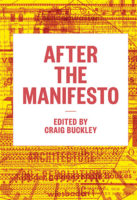Donald Trump has famously promised to build a “big beautiful wall” at the U.S.-Mexico border. Its construction could take more than three years and cost $21.6 billion, according to a report by the Department of Homeland Security, which has requested proposals for design-build prototypes. In February, Trump claimed it “is getting designed right now.” During his campaign, the President seized on the wall as a simple solution to complex problems of security and immigration. But, points out Ronald Rael, the editor of these collected writings, a wall already runs along 700 of the border’s 1,900 miles, and it is not effective: as former Secretary of Homeland Security Janet Napolitano said, “You show me a 50-foot wall, and I’ll show you a 51-foot ladder.”
Rael, an associate professor in the departments of architecture and art practice at the University of California, Berkeley, and principal of the Oakland-based firm Rael San Fratello, gathered the essays by architects, academics, and authors to rethink the existing wall. He sought ways to “exceed its sole purpose as security infrastructure” and “make positive contributions to the lives and landscapes of the borderlands.”
The book includes a proposal by architect Teddy Cruz, of the San Diego firm Estudio Teddy Cruz + Forman, to rethink border zones as public space, and an argument by Michael Dear, author of Why Walls Won’t Work: Repairing the U.S.-Mexico Divide (2015), that a border should be “a permeable membrane connecting two countries.” Contributions by writer Marcello Di Ciento and San Diego State professor Norma Iglesias-Prieto address related political and social concerns.
But the book’s heart—134 of its 200 pages—is a chapter by Rael entitled “Recuerdos/Souvenirs: A Nuevo Grand Tour.” The essay is structured as a journey along the U.S.-Mexico border, covering the same distance traveled by 18thand 19th-century English aristocrats on their pedagogical passage from London to Rome. Along the way are fictional recuerdos (memories and souvenir trinkets) that are “counter-proposals” to “reimagine, hyperbolize, or question the wall.” Though this is all a conceit too arch to be convincing, the proposals themselves, attempting to transform the boundary into something more than just an obstruction, are provocative and inventive. They include barriers that double as bicycle and pedestrian paths, aqueducts, wastewater-treatment facilities, solar collectors, and agricultural greenhouses—in other words, ideas that could lead to environmental or social improvements. Less utilitarian but nonetheless witty are an extra-long volleyball (“wall y ball”) net and a “floating wall” of welded steel tubes, which undulates with the topography, in shapes that recall Christo and Jean-Claude’s Running Fence.
The arty nature and ironic tone of some of these schemes seem odd in a book that claims to be a manifesto on an urgent political issue. But it’s consistent with Rael’s professed desire to show “how design could be a vehicle for addressing the politics of border security” that began when he and partner Virginia San Fratello assisted artists Michael Elmgreen and Ingar Dragset on Prada Marfa (2005). The faux Prada store, a “pop architectural land art project,” was built on a desolate road near the border in Valentine, Texas, not too far from Marfa.
In his final chapter, Rael clarifies that he is not endorsing the construction of more fortifications, no matter how ingenious. Instead he is suggesting that “if architecture can be smuggled into a reimagining of the existing border,” it could lead to various environmental or social improvements, “with the wall itself as the vehicle of delivery.” It’s a clever way to think about infrastructure, but it’s no solution to a big, messy, political problem.




Post a comment to this article
Report Abusive Comment